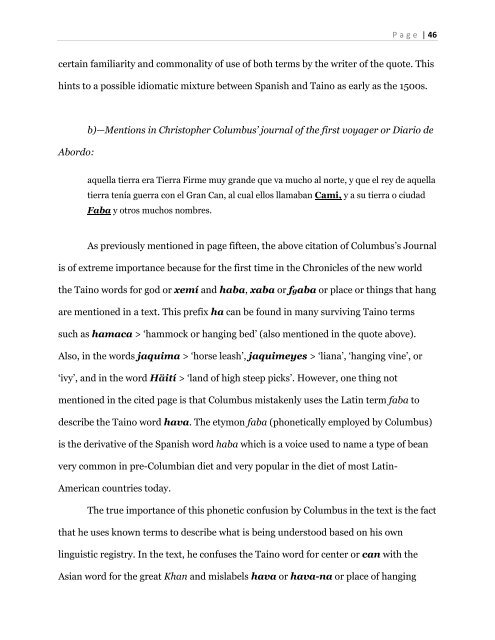Language of the Voiceless: Traces of Taino Language, Food, and Culture in the Americas From 1492 to the Present
by Leonardo Nin
by Leonardo Nin
Create successful ePaper yourself
Turn your PDF publications into a flip-book with our unique Google optimized e-Paper software.
P a g e | 46<br />
certa<strong>in</strong> familiarity <strong>and</strong> commonality <strong>of</strong> use <strong>of</strong> both terms by <strong>the</strong> writer <strong>of</strong> <strong>the</strong> quote. This<br />
h<strong>in</strong>ts <strong>to</strong> a possible idiomatic mixture between Spanish <strong>and</strong> <strong>Ta<strong>in</strong>o</strong> as early as <strong>the</strong> 1500s.<br />
Abordo:<br />
b)—Mentions <strong>in</strong> Chris<strong>to</strong>pher Columbus’ journal <strong>of</strong> <strong>the</strong> first voyager or Diario de<br />
aquella tierra era Tierra Firme muy gr<strong>and</strong>e que va mucho al norte, y que el rey de aquella<br />
tierra tenía guerra con el Gran Can, al cual ellos llamaban Cami, y a su tierra o ciudad<br />
Faba y otros muchos nombres.<br />
As previously mentioned <strong>in</strong> page fifteen, <strong>the</strong> above citation <strong>of</strong> Columbus’s Journal<br />
is <strong>of</strong> extreme importance because for <strong>the</strong> first time <strong>in</strong> <strong>the</strong> Chronicles <strong>of</strong> <strong>the</strong> new world<br />
<strong>the</strong> <strong>Ta<strong>in</strong>o</strong> words for god or xemí <strong>and</strong> haba, xaba or fgaba or place or th<strong>in</strong>gs that hang<br />
are mentioned <strong>in</strong> a text. This prefix ha can be found <strong>in</strong> many surviv<strong>in</strong>g <strong>Ta<strong>in</strong>o</strong> terms<br />
such as hamaca > ‘hammock or hang<strong>in</strong>g bed’ (also mentioned <strong>in</strong> <strong>the</strong> quote above).<br />
Also, <strong>in</strong> <strong>the</strong> words jaquima > ‘horse leash’, jaquimeyes > ‘liana’, ‘hang<strong>in</strong>g v<strong>in</strong>e’, or<br />
‘ivy’, <strong>and</strong> <strong>in</strong> <strong>the</strong> word Häití > ‘l<strong>and</strong> <strong>of</strong> high steep picks’. However, one th<strong>in</strong>g not<br />
mentioned <strong>in</strong> <strong>the</strong> cited page is that Columbus mistakenly uses <strong>the</strong> Lat<strong>in</strong> term faba <strong>to</strong><br />
describe <strong>the</strong> <strong>Ta<strong>in</strong>o</strong> word hava. The etymon faba (phonetically employed by Columbus)<br />
is <strong>the</strong> derivative <strong>of</strong> <strong>the</strong> Spanish word haba which is a voice used <strong>to</strong> name a type <strong>of</strong> bean<br />
very common <strong>in</strong> pre-Columbian diet <strong>and</strong> very popular <strong>in</strong> <strong>the</strong> diet <strong>of</strong> most Lat<strong>in</strong>-<br />
American countries <strong>to</strong>day.<br />
The true importance <strong>of</strong> this phonetic confusion by Columbus <strong>in</strong> <strong>the</strong> text is <strong>the</strong> fact<br />
that he uses known terms <strong>to</strong> describe what is be<strong>in</strong>g unders<strong>to</strong>od based on his own<br />
l<strong>in</strong>guistic registry. In <strong>the</strong> text, he confuses <strong>the</strong> <strong>Ta<strong>in</strong>o</strong> word for center or can with <strong>the</strong><br />
Asian word for <strong>the</strong> great Khan <strong>and</strong> mislabels hava or hava-na or place <strong>of</strong> hang<strong>in</strong>g


















